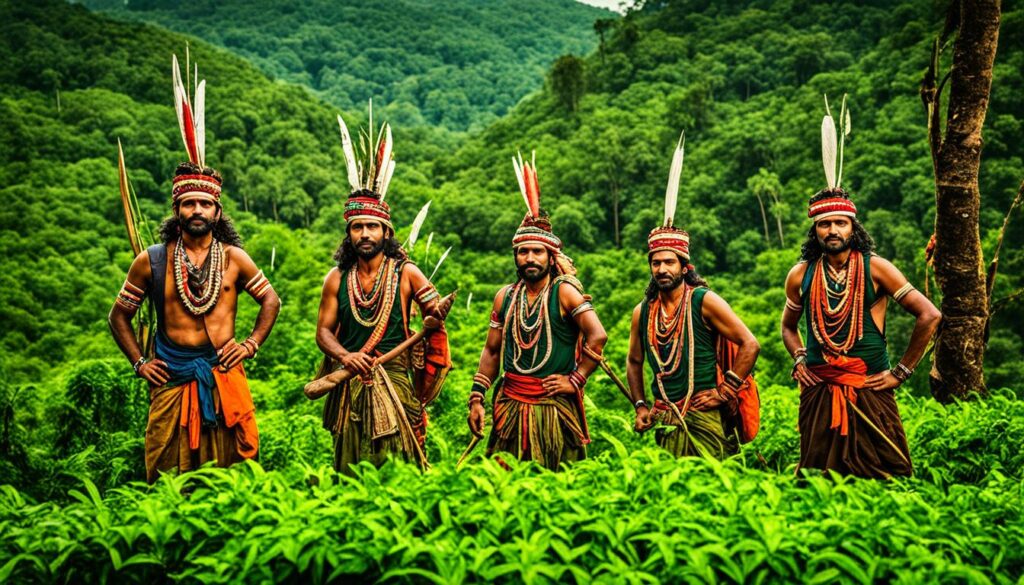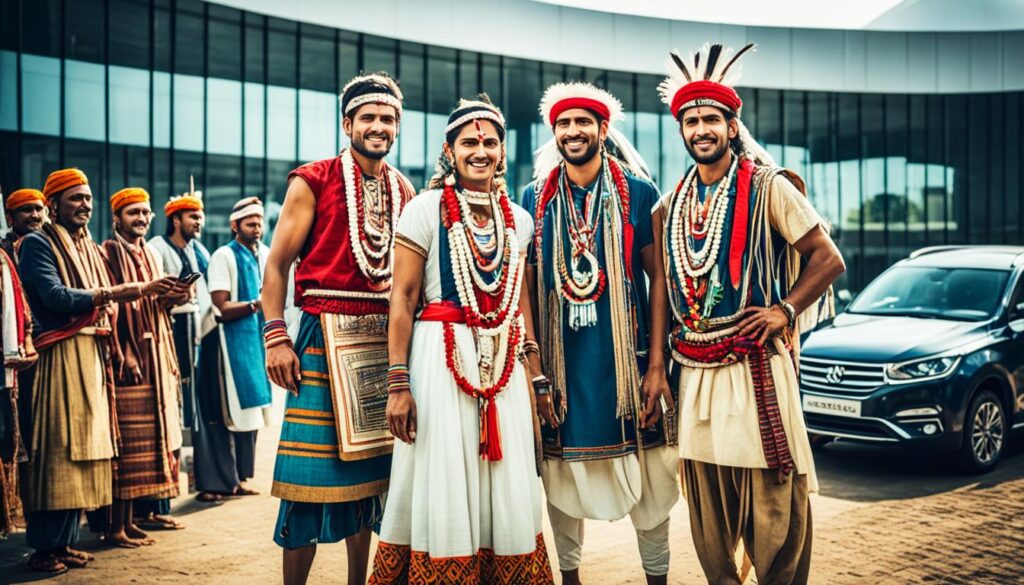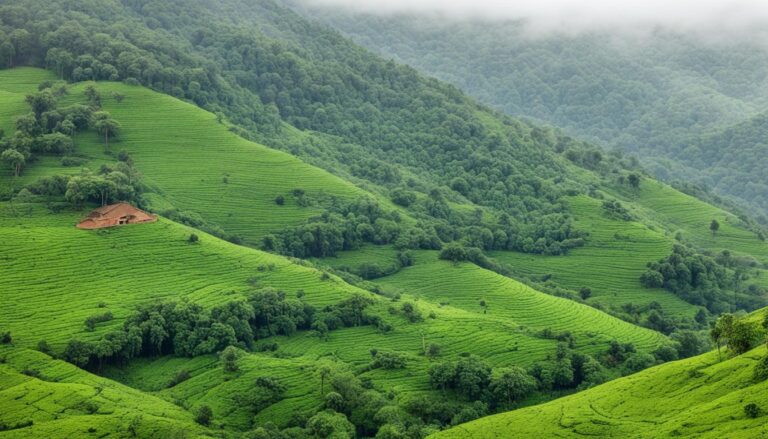Did you know the Western Ghats, a mountain range across six Indian states, houses over 50 indigenous tribes? This fact shows the area’s rich cultural diversity, covering just 6% of India. These tribes have protected one of the world’s key ecological hotspots for centuries.
The Western Ghats, from Gujarat to Kerala, mix unique cultures and ecosystems. These mountains hold ancient wisdom and practices vital for the environment. The Kadar tribe knows the forest plants well, and the Muthuvar have long traditions. Each community adds its own thread to this hidden world.
Exploring these indigenous tribes reveals their deep bond with the land. This bond has led to sustainable practices that modern conservationists are starting to see value in. The Malai Malasar tribe’s knowledge of plants shows the importance of keeping culture and nature together.
Key Takeaways
- The Western Ghats is home to over 50 indigenous tribes
- Tribal communities play a vital role in ecological conservation
- Ancient wisdom and practices contribute to sustainable living
- Ethnobotanical knowledge is crucial for understanding local biodiversity
- Preserving cultural heritage is linked to protecting natural resources
Introduction to the Western Ghats
The Western Ghats are a stunning mountain range along India’s southwestern coast. They stretch over 1,600 kilometers, offering a breathtaking view. This natural wonder is key to the region’s climate, ecology, and culture.
Geographical Significance
The Western Ghats rise to about 900 meters high, with peaks up to 2,400 meters. They act as a barrier between the coast and the interior. During the monsoon, from June to August, they get a lot of rain. This unique geography affects the weather and supports many ecosystems.
Biodiversity Hotspot
The Western Ghats are known worldwide as a place of great biodiversity. They are home to many plant and animal species found only here. Places like the Indira Gandhi Wildlife Sanctuary protect this rich biodiversity.
Cultural Diversity
There is also a rich cultural diversity in the Western Ghats. The range separates Kerala and Tamil Nadu, leading to different cultures. Indigenous communities have lived here for a long time, with their own customs and traditions.
The Western Ghats show how geography, nature, and culture are connected. This area inspires wonder and needs protection as a key part of India’s heritage.
Tribal Communities Western Ghats: An Overview
The Western Ghats is a hotspot for biodiversity and home to diverse tribal groups. These communities have thrived in harmony with nature for centuries. They have developed unique knowledge systems.
Major Tribal Groups
The Western Ghats are home to many tribal communities, each with their own traditions. The Kadar, Muthuvar, Malai Malasar, Irulas, Kurumbas, and Badagas are some of the main groups. They have long relied on trade networks to exchange goods and services.
Historical Background
Originally, many tribes in the Western Ghats were hunter-gatherers. Over time, they adapted to settled lifestyles while keeping their cultural roots. This change has brought about big shifts in their social structures and ways of living.
Cultural Significance
The tribal groups in the Western Ghats hold a lot of cultural importance. Their unique languages, customs, and knowledge systems are key parts of India’s cultural diversity. In recent decades, their population has grown by 180%, and literacy rates have risen.
| Aspect | Data |
|---|---|
| Population Growth | 180% increase in past three decades |
| Overall Literacy Rate | 52% |
| Female Literacy Rate | 42% |
| Male Literacy Rate | 63% |
The tribal communities in the Western Ghats are key to preserving the region’s ecological balance and cultural diversity. Their knowledge and sustainable practices are valuable for conservation efforts in this unique area.
The Kadar Tribe: Guardians of the Forest

The Kadar tribe shines as a symbol of deep forest knowledge in the Western Ghats. They live in the Anamalai hills, connecting deeply with their forest. Their lifestyle shows how to protect the forest, making them its true protectors.
Kadar people know the local ecosystem well. They spot many plant species and know how to use them safely. This knowledge helps keep their forest healthy.
“Our ancestors taught us to take only what we need from the forest. It gives us life, so we must protect it,” shares a Kadar elder.
Even with modern changes, the Kadar keep their forest values strong. Many work with the Forest Department, using their knowledge to help protect the forest. This shows how native wisdom and science can work together.
The Kadar teach us about living sustainably. They gather forest products in a way that helps the forest grow back. By learning from them, we can find better ways to protect our forests.
Muthuvar: Preserving Ancient Traditions
The Muthuvar tribe is a symbol of cultural strength in the Western Ghats. They have kept their rich culture alive despite modern changes.
Unique Customs and Rituals
The Muthuvar tribe has special customs that show their bond with nature. Their weddings include rituals tied to the forest. At harvest festivals, they dance to thank nature for its gifts.
Traditional Knowledge Systems
Muthuvar elders know a lot about plants and animals. They use plants for medicine and understand the forest well. This knowledge is shared from one generation to the next.
| Traditional Knowledge | Application |
|---|---|
| Herbal Medicine | Treating common ailments |
| Forest Navigation | Sustainable resource gathering |
| Weather Prediction | Agricultural planning |
Challenges in Modern Times
The Muthuvar tribe faces big challenges in keeping their culture alive. Their land is being taken over, and economic changes threaten their way of life. Young ones often leave for school and jobs, taking their traditions with them.
Even with these problems, the Muthuvar tribe is dedicated to saving their culture. They’re working with local groups to record their traditions and spread the word about their customs. By changing with the times but keeping their values, the Muthuvar aim to keep their old ways alive today.
Malai Malasar: Experts in Ethnomycology
The Malai Malasar tribe in the Western Ghats is known for their deep knowledge of wild mushrooms. They have learned about these mushrooms from their ancestors. This knowledge has been passed down for many years.
They have found many edible mushroom species. Their knowledge covers different types of fungi. This includes:
- Identification of at least 19 distinct edible mushroom species
- Recognition of mushrooms from 12 different genera
- Classification across 9 families and 4 orders
The tribe lives closely with the forest. This has given them a deep understanding of where mushrooms grow and when they are ready to eat. They know how to harvest mushrooms in a way that doesn’t harm the environment.
They also know how to keep mushrooms fresh for a long time. This helps them have a steady food supply during hard times.
The Malai Malasar’s knowledge about mushrooms is very useful for many things. It could help with:
- Enhancing nutritional studies
- Developing new medicinal applications
- Informing conservation efforts in the Western Ghats
Learning about the Malai Malasar and their relationship with the forest teaches us a lot. It shows us the importance of traditional knowledge in protecting nature.
Tribal Livelihoods and Resource Use
The Western Ghats’ tribal communities live in harmony with nature. They depend on the area’s rich biodiversity. This shows a strong bond with the environment.
Traditional Occupations
Tribal groups have activities that go back to their ancestors. They gather forest products, farm on a small scale, and make crafts. Many grow crops like millet and vegetables for food, keeping their culture alive.
Sustainable Practices
For generations, tribes in the Western Ghats have used sustainable ways to manage resources. This helps protect the environment and meet their needs. For instance, they harvest forest products in a way that lets nature heal itself.
Adapting to Change
As the world changes, tribal communities are changing too. Some are starting to grow cash crops, like cardamom. This shows they can adapt and use new ways to make money while keeping their old knowledge.
| Traditional Livelihood | Modern Adaptation | Impact on Community |
|---|---|---|
| Forest gathering | Sustainable harvesting cooperatives | Improved market access, fair prices |
| Subsistence farming | Cash crop cultivation (e.g., cardamom) | Increased income, economic stability |
| Artisanal crafts | Eco-tourism initiatives | Cultural preservation, new revenue streams |
Despite the challenges, tribal communities are changing their ways. They keep their culture while adapting to new practices. This shows how they can use resources wisely and stay strong as a community.
Cultural Heritage and Ethnobotanical Knowledge
The Western Ghats’ tribal communities have a deep cultural heritage. Their ethnobotanical knowledge is passed down through generations. It shapes their identity and life.
Tribal elders are like living encyclopedias of traditional medicine. They know hundreds of plant species and their uses. This knowledge helps them treat illnesses and keep healthy every day.
“Our forests are our pharmacies. Every leaf, bark, and root has a purpose,” says Muthamma, a respected healer from the Kadar tribe.
The tribes’ knowledge goes beyond medicine. It includes sustainable farming, food preservation, and managing natural resources. These methods keep the Western Ghats’ ecosystem balanced for centuries.
- Medicinal plants used for various ailments
- Traditional cultivation methods
- Sustainable harvesting techniques
- Natural conservation practices
This mix of culture and ethnobotanical knowledge is valuable for today’s science. Researchers work with tribes to find new uses in pharmaceuticals, farming, and saving biodiversity.
With environmental issues growing, saving this knowledge is crucial. It’s not just about keeping culture alive. It’s about protecting wisdom that could help all of humanity.
Conservation Efforts and Tribal Involvement
The Western Ghats’ conservation efforts now include tribal communities as key partners. This change recognizes the deep bond between indigenous people and their environment. It leads to better ways to protect biodiversity.
Community-based Conservation Initiatives
Tribal groups are now part of conservation efforts on their ancestral lands. They use both modern science and traditional practices. This mix creates a complete way to manage ecosystems.
Traditional Ecological Knowledge in Conservation
Knowledge passed down through generations is vital for conservation. Tribal communities use their traditional knowledge to find rare species, understand animal behavior, and keep the ecosystem balanced.
| Traditional Knowledge | Conservation Application |
|---|---|
| Medicinal plant use | Sustainable harvesting practices |
| Wildlife tracking | Population monitoring |
| Fire management | Controlled burning for habitat renewal |
Challenges and Opportunities
Tribal involvement in conservation has many benefits but also faces challenges. Finding a balance between traditional ways of living and modern conservation goals is hard. Yet, these partnerships offer chances for sustainable development and protecting biodiversity in the Western Ghats.
“Our ancestors taught us to live in harmony with nature. Now, we work with scientists to protect our forests for future generations,” says Ravi, a Kadar tribe elder.
As conservation efforts grow, combining tribal knowledge with modern science leads to better ways to protect the Western Ghats’ biodiversity.
Impact of Modernization on Tribal Communities
The Western Ghats’ tribal communities are at a turning point as modern life moves in. This change brings both good and bad, affecting their identity and traditional life.

Education and better infrastructure are bringing new life to these distant places. More people can read, and healthcare is getting better. But, this progress has its downsides.
Many tribes are leaving their nomadic ways for a settled life. This change is affecting their old customs and ways.
It’s hard for these communities to keep their identity as they modernize. Young ones often feel caught between keeping their heritage and new chances. This creates a world where old knowledge meets new tech.
“Our children learn about smartphones and computers, but we fear they might forget the wisdom of our ancestors,” says a Kadar tribe elder.
New jobs are coming to tribal lands, offering stability. But, they also threaten the old ways of making a living. Finding a balance between growth and keeping culture is tough for these groups.
- Increased access to education and healthcare
- Shift from nomadic to settled lifestyles
- Introduction of new economic opportunities
- Erosion of traditional knowledge systems
As these communities face change, they must blend new tech with their deep culture. This will be key to their future.
Conclusion
The Western Ghats’ tribal communities are rich in knowledge and traditions. They are crucial in conservation efforts. Their deep bond with the land gives them unique insights for sustainable development.
These tribes now face new challenges as times change. They must blend their traditional life with modern pressures. Keeping their culture alive is essential in this balance.
We need new ideas for the future. Combining old wisdom with new science can make a big impact. By working together, we can use tribal knowledge for conservation. This approach will benefit both people and nature in the Western Ghats.
